View in other NatureServe Network Field Guides
NatureServe
Montana
Utah
Wyoming
Idaho
Wisconsin
British Columbia
South Carolina
Yukon
California
New York
Rainbow Smelt - Osmerus mordax
General Description
Montana has one member of the smelt family, courtesy of North Dakota. The rainbow smelt was introduced into Garrison Reservoir in 1971 as a forage fish for sport fishes. In 1979 it was first collected in eastern Montana below Fort Peck Dam. Its adipose fin and strong canine teeth make this species easy to identify. Rainbow smelt are spring broadcast spawners. They live in lake waters most of the time but run into streams to spawn. This species supports a commercial fishery in the Great Lakes, and a sport fishery in the tributaries when they make their spawning runs. Rainbow smelt eat insects, crustaceans and, as adults, fish. It is this latter feature that makes them undesirable as a forage fish. Their maximum size is about 10 inches in length. They are only occasional Montana residents.
Diagnostic Characteristics
Silvery with pink and purple iridescence, greenish or black. Smelts are small, slender fishes with an adipose fin and no pelvic axillary process. Scales thin and easily rubbed off. Spawning males feel like sandpaper due to numerous small nuptial tubercles on head, body and fins.
Species Range
Montana Range
Range Descriptions
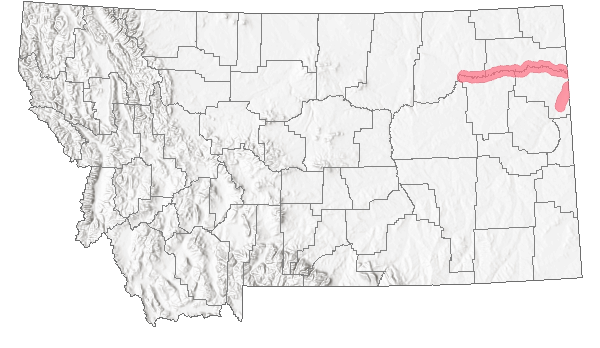
 Non-native
Non-native
Observations in Montana Natural Heritage Program Database
Number of Observations: 12
(Click on the following maps and charts to see full sized version)
Map Help and Descriptions
Relative Density
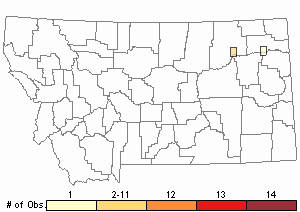
Recency
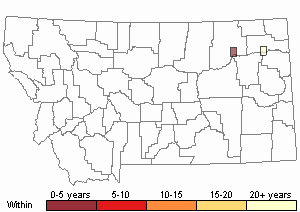
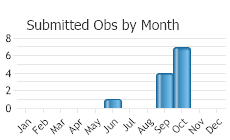
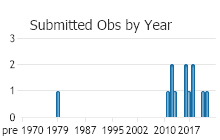
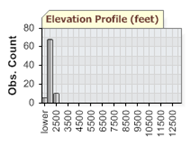 (Observations spanning multiple months or years are excluded from time charts)
(Observations spanning multiple months or years are excluded from time charts)
Migration
Spawning runs up Missouri and Yellowstone River from Garrison reservoir North Dakota.
Habitat
Found in cool-water lakes and associated tributary streams. Usually spawn in streams but also over shallow gravel deltas near shore.
Food Habits
Adults in Great Lakes eat mostly larger crustaceans. May consume many fish in inshore waters. Virtually stop feeding during spawning season. Cannibalistic.
Ecology
It is probable the majority of smelt found in state occur as seasonal spawning runs from Garrison reservoir North Dakota though a few are collected all year long in dredge cuts below Ft. Peck dam.
Reproductive Characteristics
Spawns in 2 weeks from late March-early May when water temperatures reach 40 degrees F. or higher, shortly after ice-out. Broadcasts spawn. Incubation: 20-30 days at prevailing temperatures. Sexually mature in 2-3 years in Lake Superior.
Stewardship Responsibility
References
- Additional ReferencesLegend:
 View Online Publication
View Online Publication
Do you know of a citation we're missing? Brandt, S., and S. Madon. 1986. Rainbow smelt, Osmerus mordax, predation on slimy sculpin, Cottus cognatus, in Lake Ontario. J. Great Lakes Res. 12:322-325.
Brandt, S., and S. Madon. 1986. Rainbow smelt, Osmerus mordax, predation on slimy sculpin, Cottus cognatus, in Lake Ontario. J. Great Lakes Res. 12:322-325. Gould, W.R. 1981. First records of the rainbow smelt (Osmeridae), sicklefin chub (Cyphnidae), and white bass (Percichthyidge) from Montana. Proc. MT. Acad. Sci. 40:9-10.
Gould, W.R. 1981. First records of the rainbow smelt (Osmeridae), sicklefin chub (Cyphnidae), and white bass (Percichthyidge) from Montana. Proc. MT. Acad. Sci. 40:9-10. Joslin, Gayle, and Heidi B. Youmans. 1999. Effects of recreation on Rocky Mountain wildlife: a review for Montana. [Montana]: Montana Chapter of the Wildlife Society.
Joslin, Gayle, and Heidi B. Youmans. 1999. Effects of recreation on Rocky Mountain wildlife: a review for Montana. [Montana]: Montana Chapter of the Wildlife Society. Mayden, R.L., F.B. Cross, and O.T. Gorman. 1987. Distributional history of the rainbow smelt, Osmerus mordax (Salmoniformes: Osmeridae), in the Mississippi River Basin. Copeia 1987(4):1051-1054.
Mayden, R.L., F.B. Cross, and O.T. Gorman. 1987. Distributional history of the rainbow smelt, Osmerus mordax (Salmoniformes: Osmeridae), in the Mississippi River Basin. Copeia 1987(4):1051-1054. Montana Department of Fish, Wildlife and Parks. 1989. Northeast Montana Warmwater Ecosystem Investigations: project period 7/1/88 through 6/30/89. Proj.# F-46-R-2; Job# V-e. 21p.
Montana Department of Fish, Wildlife and Parks. 1989. Northeast Montana Warmwater Ecosystem Investigations: project period 7/1/88 through 6/30/89. Proj.# F-46-R-2; Job# V-e. 21p. Selgeby, J. H., W. R. MacCallum, and M. H. Hoff. 1994. Rainbow smelt-larval lake herring interactions: competitors or casual acquaintances? Washington, D.C.: USDI National Biological Survey, Biological Report 25. 9 p.
Selgeby, J. H., W. R. MacCallum, and M. H. Hoff. 1994. Rainbow smelt-larval lake herring interactions: competitors or casual acquaintances? Washington, D.C.: USDI National Biological Survey, Biological Report 25. 9 p.
- Web Search Engines for Articles on "Rainbow Smelt"
- Additional Sources of Information Related to "Fish"





